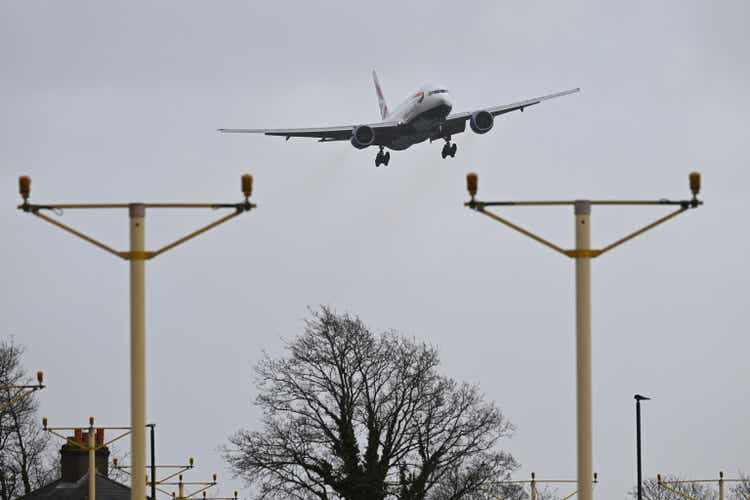Leon Neal/Getty Images News
The table below illustrates the shipments for The Boeing Company (BA) and Airbus SE (OTCPK:EADSF, OTCPK:EADSY) in the last two quarters.
| Q1 and Q2 2022 Commercial Aircraft Shipments | |||
| Boeing | Q1 | Q2 | % Increase |
| 737 | 86 | 103 | 20% |
| 787 | – | – | |
| 747 | 1 | 2 | 100% |
| 767 | 5 | 7 | 40% |
| 777 | 3 | 9 | 200% |
| total | 95 | 121 | 27% |
|
|||||||||||||||||||||||||||||||||||||
Boeing Shipments
In my last analysis, I projected shipments of 737s totaling 103 units, which turned out to be the case. However, I assumed lower wide-bodied shipments due to lower first quarter performance on these products and high 737 new aircraft production.
Boeing was trying to achieve new production of 31 units per month. They were having difficulty achieving that level of production, but refurbished units from inventory were added to the 737 shipments. Wide body production was at its maximum rate in the second quarter.
Boeing 737 Shipments were up 20%. Shipments in total increased by 27%. The wide-bodied aircraft is about twice as expensive as the single-bodied, so the revenue went up by about 1/3. Without the large write-offs in the first quarter, Boeing’s second-quarter results should be much improved and probably turn a profit.
Boeing is having difficulty refurbishing the inventory of 737s as they are expanding more labor on the refurbishment than on new construction because of the changes and specifications. They are slowly improving the efficiency but have 340 units to refurbish. They were to complete all the refurbishing by the end of 2023. Now the plan is to complete most of the 737s by the end of 2023, but even that requires a drastic increase in output.
Airbus Shipments
Shipments exceeded Boeing by 26%. Airbus production was up 8%. The 320 family was up 11%, and the newly acquired 220 family had the highest growth rate of 27%. The narrow-body aircraft are suffering from a lack of engines. Neither Boeing, which is targeting new construction of 737s at 31 units per month, nor Airbus, which is targeting the 320 neo family at 45 units a month, has been able to meet those goals because of a lack of engines and other equipment. Boeing’s problems are less because their production goal is smaller, and they can refurbish 737s in inventory.
Airbus continues to predict that it will ship 720 commercial aircraft, but in the first half, they shipped 295 units, 41% of that commitment. The risks that they will not achieve the deliveries drag the stock down.
Boeing Q3 Shipments
During the first quarter review, Boeing CFO Brian West stated that the first quarter was the bottom of earnings and cash flow. He predicted that earnings and cash flow will increase in each of the quarters. That was partly a reflection of his planning, with large write-offs of all fixed price defense contracts in the first quarter. The second quarter has both higher widebody production at the maximum rate and an increased 737 production.
Boeing management has been stating that the 787 will restart deliveries in the third quarter. Boeing has told airlines and its suppliers that the shipments will begin. The third quarter should see the beginning of the surging 787 production and refurbished inventory. Boeing has also taken 787 units out of inventory and began to prepare them for delivery.
Boeing has also taken the position that it will get congressional approval to wave the law requiring improved recovery software shows that customers can be assured the 737-10 and the 737 -7 will be produced regardless of any FAA delays that push certification past yearend.
Boeing has suffered as the FAA and the Department of Transportation have tried to recover from their failures. Boeing has gotten additional orders for 100 737-10 at the Farnborough show along with 30 options. The dash 10 is a participant in the flying exhibit at the show. This is exciting, but deliveries will not begin on this Delta Air Lines order until 2025, so its direct impact on stock prices is limited.
What is most significant is that Boeing is beginning to push back against the FAA. Boeing is now discussing with customers its new, much-postponed smaller aircraft that competes against the Airbus A321XLR. This is a clean sheet design that, because of the digital models used by both Engineering and Manufacturing, they expect to be able to produce the plane in about five years. However, with the higher certification standards, they may make it a 10-year program. All of this assumes that the current Secretary of Transportation will be around. If a Republican administration replaces him, then it could be a five-year program.
Airbus Orders
Airbus will see the first flight of the 321 at yearend. This will leave them with a stronger position with an unchallenged model in the hot single market. Airbus also has strong 300-unit Chinese orders. This shows that Airbus can be very strong and is only held back by a lack of engines and other supply chain limitations.
Conclusion
Boeing will have a stronger year in the stock market than Airbus, but both companies have a growing market because of all the units that were scrapped during the pandemic. The aircraft market should outperform most industries in a difficult stock market.


Be the first to comment